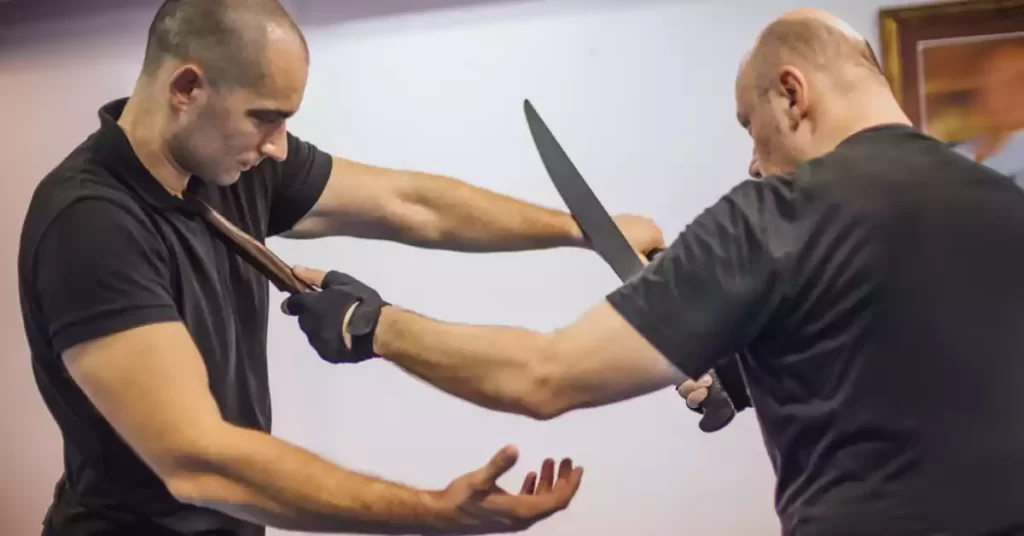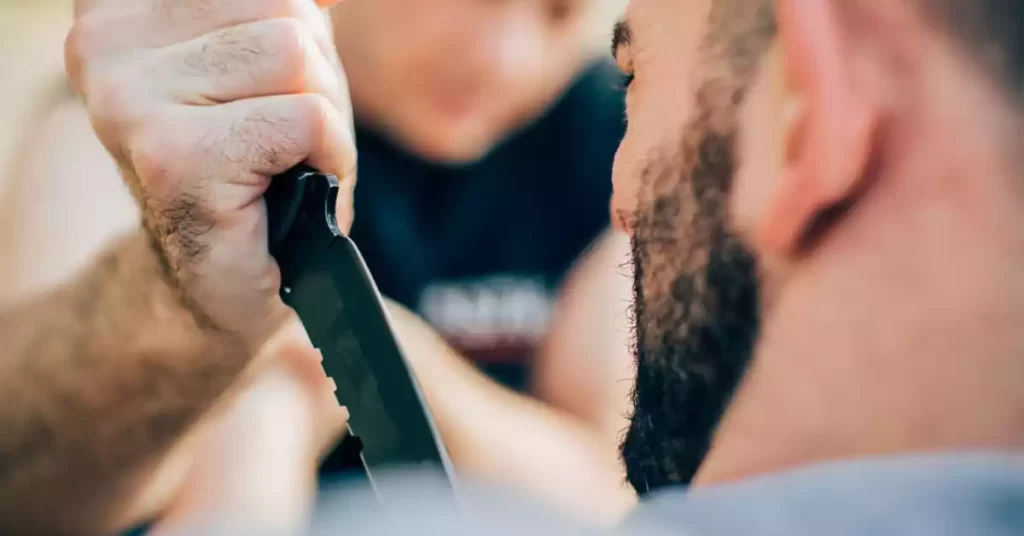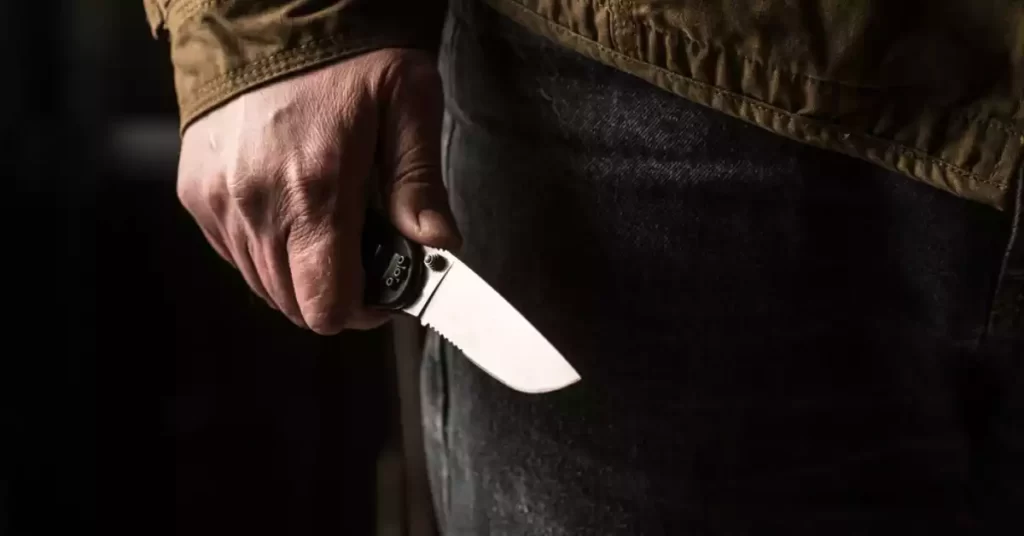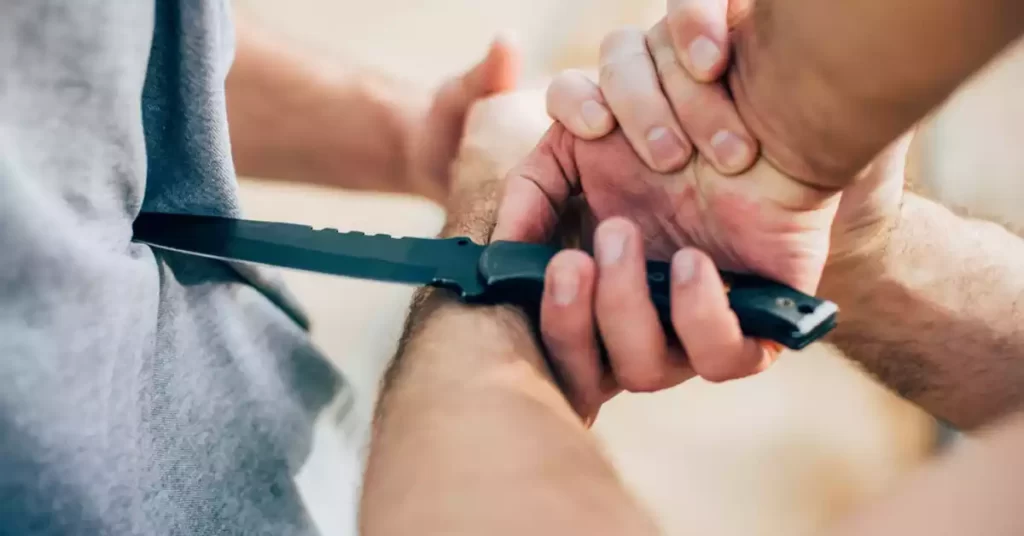The art of knife fighting is ancient, with roots deep in the history of human conflict. Humans have always found a way to protect themselves in dire situations, and one such method that stood the test of time is knife fighting. It’s not only a martial arts discipline but also an integral part of many cultures worldwide.
Among the numerous knife fighting systems that have evolved over the centuries, two have particularly captivated me: Apache Knife Fighting and Filipino Knife Fighting. Each one carries its own unique set of techniques, philosophies, and application scenarios, shaping their specific strengths and weaknesses.
The Apache Knife Fighting techniques hail from the warrior culture of the Native American Apache tribe, while Filipino Knife Fighting, also known as Eskrima, Kali, or Arnis, has its roots in the Philippines’ archipelago. Both systems are rich, fascinating, and worth exploring for any knife fighting practitioner.
Apache Knife Fighting Techniques
Origins and Evolution
Apache Knife Fighting has its roots deeply embedded in the Native American Apache tribes’ lifestyle, more specifically, the warrior culture. Life in the Southwestern United States, the Apaches’ homeland, was harsh and unpredictable, and individuals needed to be prepared for combat situations at any time. The Apaches developed a specific set of combat skills to defend themselves against rival tribes and predatory animals, which eventually evolved into a formal knife fighting system.
Unlike many other martial arts, Apache Knife Fighting is not a product of centuries of peaceful refinement. Instead, it’s a fighting style born from real-life survival needs and warfare scenarios. These high-stakes origins made Apache Knife Fighting a pragmatic and efficient method of defense and attack, and the techniques remain relevant today.

Key Principles and Techniques
In Apache Knife Fighting, the knife is considered an extension of the hand. This perspective makes the movements feel more natural and intuitive, reducing the barrier between the person and the weapon. Apache techniques emphasize speed, accuracy, agility, and a keen understanding of the opponent’s movements.
The techniques involve a combination of slashes, stabs, and knife throws. Some of the most prominent techniques are the forward stab, the backhand slash, and the overhand strike. These are grounded in a strong foundation of footwork and body movement. By training in Apache Knife Fighting, practitioners learn to move their bodies efficiently and to exploit openings in their opponent’s defenses.
Strengths and Weaknesses
One of the major strengths of the Apache system lies in its simplicity and practicality. The techniques are straightforward and easy to execute under stress, which is particularly important in a real-life self-defense situation. Apache Knife Fighting also emphasizes physical fitness and agility, leading to overall physical improvements for practitioners.
However, the simplicity that gives the Apache system its strengths also contributes to its weaknesses. The system does not offer a wide range of movements, and it heavily relies on the practitioner’s physical abilities and reflexes. This reliance means that individuals with physical limitations may find it difficult to fully utilize Apache techniques.

Filipino Knife Fighting
History and Development
Filipino Knife Fighting, also known as Eskrima, Kali, or Arnis, is a martial art that has evolved over centuries in the Philippine archipelago. The Philippines’ geographical characteristics—being composed of more than 7,000 islands—meant that different regions developed their own distinct fighting styles. Over time, these styles blended together, creating a rich and diverse martial art system.
Filipino Knife Fighting was not solely developed for warfare; it was also used in duels of honor and for settling disputes. This led to a fighting style that’s not only practical but also aesthetically pleasing and rhythmically entrancing.
Core Techniques and Concepts
Filipino Knife Fighting is characterized by its fluidity and rhythm. The movements are smooth and circular, drawing inspiration from the natural flow of water. Practitioners are trained to seamlessly switch from offense to defense and to move rhythmically as if dancing.
Techniques in Filipino Knife Fighting involve a combination of strikes, thrusts, and parries. Footwork is a key element, enabling practitioners to control distance and positioning. The Filipino system also introduces practitioners to the concept of ‘flow’, a state where movements are connected seamlessly.
Pros and Cons
One of the major strengths of the Filipino system is its adaptability. The fluidity of movements allows practitioners to adapt quickly to changing circumstances and to seamlessly transition between offense and defense.
Moreover, Filipino Knife Fighting’s focus on using natural body movements to generate power and speed offers an inherent efficiency to its techniques. This art form’s rich history and cultural ties also give practitioners a deeper appreciation for the philosophy behind the physical movements, adding an extra layer of meaning to their practice.
However, the complexity and variety of techniques in Filipino Knife Fighting can also present challenges, particularly for beginners. The learning curve may be steeper compared to more straightforward systems like Apache Knife Fighting.
Mastery of the ‘flow’ concept, a critical component of Filipino Knife Fighting, can also take considerable time and practice. Despite these challenges, many practitioners find the depth and richness of the Filipino system well worth the investment of time and effort.

Comparative Analysis: Apache vs. Filipino Knife Fighting
Differences in Techniques and Applications
Apache and Filipino knife fighting systems, despite both being rooted in survival and self-defense, differ significantly in their techniques and applications. The Apache system’s techniques are straightforward and direct, with a focus on attacking the opponent quickly and efficiently. In contrast, the Filipino system employs more fluid, circular movements that allow for a smooth transition between offense and defense.
In terms of application, the Apache system’s strength lies in its straightforwardness. It’s ideal for situations that call for quick, decisive action. On the other hand, the Filipino system’s fluidity makes it adaptable to a wider variety of scenarios. Its emphasis on footwork and body movement also provides a tactical advantage in situations that require movement and positioning.
Suitability for Different Scenarios
When it comes to choosing between the Apache and Filipino knife fighting systems, the choice largely depends on the individual’s goals and preferences. The Apache system’s simple and direct techniques might appeal to those seeking a pragmatic and intuitive approach to self-defense. Its practical nature makes it suitable for high-stress scenarios where there is little time to react.
On the other hand, the Filipino system’s fluid and rhythmic approach might appeal to individuals interested in the artistry of martial arts. Its adaptability and the emphasis on the flow of movements make it an excellent choice for those who wish to engage in a deep study of martial arts. Additionally, it offers a broader range of techniques, which could be beneficial in situations that require versatility.
Impact on the Trainee’s Development
Beyond their practical applications, both systems also offer distinct developmental benefits for practitioners. Training in the Apache system can lead to improvements in physical fitness, agility, and reaction times. It also cultivates a direct and focused mindset, which can be beneficial in various areas of life.
In contrast, training in the Filipino system can enhance coordination, rhythm, and spatial awareness. It also encourages adaptability and quick thinking, qualities that are useful in many life scenarios. Moreover, the philosophy and history ingrained in Filipino knife fighting can offer cultural and historical insights to the practitioners.

Training and Practice Considerations
Finding a Reputable School or Instructor
Regardless of the knife fighting system chosen, it’s crucial to find a reputable school or instructor. A good instructor should be knowledgeable, experienced, and able to provide safe and effective training. They should also have a deep understanding of the system’s philosophy and techniques.
Importance of Regular Practice
Like any martial art, proficiency in knife fighting requires regular practice. This includes not only training in techniques but also conditioning the body and mind to react instinctively under pressure. Regular practice also helps to refine techniques and improve speed, precision, and power.
Safety Measures in Knife Fighting Training
Safety should always be a priority when practicing knife fighting. This includes using training knives during practice and wearing appropriate protective gear. Practitioners should also learn and adhere to safety rules, such as handling the knife responsibly and respecting their training partners.
Personal Experiences with Apache and Filipino Techniques
My Journey in Apache Knife Fighting
I’ve had the privilege of studying Apache Knife Fighting under some exceptional teachers. My journey in this system has been challenging yet rewarding. The simplicity and directness of Apache techniques have helped me develop a focused and decisive mindset.
Insights Gained from Filipino Knife Fighting
In contrast, my training in Filipino Knife Fighting has been a rhythmical and flowing experience. The fluid movements and emphasis on the concept of ‘flow’ have helped me improve my adaptability and spatial awareness. It has also provided me with a deep appreciation for the rich cultural and historical background of this martial art.
Real-life Applications and Encounters
Both systems have proven valuable in real-life applications. While I have thankfully never had to use these techniques in an actual combat situation, the skills I’ve learned have greatly improved my confidence and physical capabilities. They have also enriched my life in surprising ways, influencing my approach to problem-solving and decision-making.
Frequently Asked Questions
What is the Best Knife Fighting System?
The ‘best’ knife fighting system largely depends on the individual’s needs, preferences, and goals. Both Apache and Filipino knife fighting systems offer valuable skills and benefits. It’s advisable to try out both systems, if possible, to see which one resonates with you more.
How Long Does it Take to Learn Knife Fighting?
Learning knife fighting is a continuous journey rather than a destination. You can learn the basic techniques within a few months of regular training. However, mastering the art can take years or even a lifetime of practice.
Is Knife Fighting Practical for Self-defense?
Yes, knife fighting can be practical for self-defense. However, it’s important to remember that the goal of self-defense is to escape from danger, not to engage in combat. Knife fighting techniques can provide confidence and skills to protect oneself, but they should be used responsibly and ethically.
A Final Word on Knife Fighting Systems
Choosing between Apache and Filipino knife fighting techniques ultimately comes down to individual preference. Each system has unique attributes that can enrich the practitioner’s life in different ways. The Apache system’s practical and straightforward approach contrasts beautifully with the Filipino system’s fluid and rhythmic nature.
I encourage you to explore both systems and immerse yourself in their unique philosophies and techniques. Whether you prefer the decisive simplicity of Apache Knife Fighting or the flowing adaptability of Filipino Knife Fighting, both systems offer a path to personal growth and an invaluable set of self-defense skills.
Remember, the journey in any martial art is not just about mastering techniques. It’s about personal development, gaining confidence, improving physical capabilities, and, most importantly, understanding and respecting the power and responsibility that comes with wielding a weapon.

Hi Justin! I’m not sure where you got your information about Apache Knife. Apache Knife Combat, as taught by Robert Redfeather, a Mescalero Apache, is very different than what is described. I see that you are in the LA area. We have seminars on a regular basis if you would like to check out his family system! Apache-Knife. com
Hi Robin! Thank you for your valuable input and sharing your knowledge about Apache Knife Combat. I appreciate your cooperation. I have recently updated the article to address the misconception. I would love to hear your feedback after giving it another read. Thank you again!
Hi Justin! I do like the update better than the original. I would still urge you to come to one of our seminars. I’d even be happy to meet with you during the week and give you an example! (I’m retired so I have time!) I believe I know who you may have trained with and his method is different than the Redfeather family system.